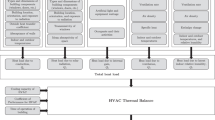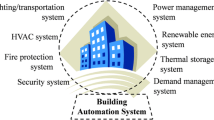Abstract
While the primary purpose of most buildings is to provide a safe and comfortable environment for its occupants, most of the current studies and solutions developed for building thermal control have been designed independent of the occupant feedback. An acceptable temperature range for the occupancy level is estimated, and control input is designed to maintain temperature within that range during occupancy hours. Consider office floors, conference rooms, student dorms, homes, and other multi-occupant spaces where temperature is chosen irrespective of the number of occupants and their individual preferences. This existing approach is not only non- user-centric but also suboptimal from both energy consumption and occupant satisfaction/productivity perspectives. It is thus highly desirable for such multi-occupant spaces to have a mechanism that would take into account each occupant’s individual comfort preference and the energy cost, to come up with optimal thermal setting. Individual occupant’s feedback and preference can be obtained through wearable sensors or smart phone applications. In this chapter, we propose algorithms that take into account each occupant’s preferences along with the thermal correlations between different zones in a building, to arrive at optimal thermal settings for all zones of the building in a coordinated manner. First, we present a control algorithm that uses binary occupant feedback based on singular perturbation theory to minimize aggregate user discomfort and total energy cost. A consensus algorithm for attaining a common temperature setpoint in a typical multi-occupant space is presented next that uses Alternating Direction Method of Multipliers (ADMM) to solve the consensus problem. We use our Watervliet, NY-based test facility to demonstrate the performance of our algorithms.
Parts of the work in this chapter have been extracted from [1] (©[2015] IEEE. Reprinted, with permission, from S.K. Gupta, K. Kar, S. Mishra, J.T. Wen, “Collaborative energy and thermal comfort management through distributed consensus algorithms,” IEEE Trans. Automation Science and Eng., vol. 12, no. 4, pp. 1285–1296, Oct. 2015.).
Similar content being viewed by others
References
Gupta SK, Kar K, Mishra S, Wen JT (2015) Collaborative energy and thermal comfort management through distributed consensus algorithms. IEEE Trans Autom Sci Eng 12(4):1285–1296
Guo W, Zhou M (2009) Technologies toward thermal comfort-based and energy efficient HVAC systems: A review. In: Proceedings of the IEEE international conference on systems, man and cybernetics, Oct. 2009. San Antonio, TX
Karjalainen S, Koistinen O (2007) User problems with individual temperature control in offices. Build Environ 42(8):2880–2887
Times union (2016). http://www.timesunion.com/news/article/This-cold-war-too-has-roots-in-the-past-6422917.php/. Accessed Mar 21 2016
Ma Y, Anderson G, Borrelli E (2011) A distributed predictive control approach to building temperature regulation. In: Proceedings of the american control conference, San Francisco, CA, Jun–Jul 2011
Erickson VL, Cerpa AE (2012) Thermovote: Participatory sensing for efficient building hvac conditioning. In: BuildSys 2012 Proc. Fourth ACM Workshop on embedded sensing systems for energy efficiency in buildings, Toronto, ON, Canada, 2012
Home nest (2016). http://www.nest.com. Accessed 21 Mar 2016
Hoff JV (2008) Forty years of fanger’s model of thermal comfort: Comfort for all? Indoor Air 18(3):182–201
Humphreys MA, Hancock M (2007) Do people like to feel neutral?: Exploring the variation of the desired thermal sensation on the ASHRAE scale. Energy Build 39(7):867–874
McIntyre DA (1982) Chamber studies reductio ad absurdum? Energy Build 5(2):89–96
ASHRAE (2004) Thermal environmental conditions for human occupancy, ASHRAE Standard 55-2004, 2004
Fanger PO (1972) Thermal comfort. Analysis and applications in environmental engineering. McGraw-Hill, New York
Kolokotsa D, Niachou K, Geros V, Kalaitzakis K, Stavrakakis GS, Santamouris M (2005) Implementation of an integrated indoor environment and energy management system. Energy Build 37(1):93–99
Dalamagkidis K, Kolokotsa D, Kalaitzakis K, Stavrakakis GS (2007) Reinforcement learning for energy conservation and comfort in buildings. Building Environ 42(7):2686–2698
Bermejo P, Redondo L, Ossa L, Puerta JM (2012) Design and simulation of a thermal comfort adaptive system based on fuzzy logic and online learning. Energy Build 49(6):367–379
Tse WL, Chan WL (2008) A distributed sensor network for measurement of human thermal comfort feelings. Sens Actuators A: Phys 144(2):394–402
Kang J, Kim Y, Kim H, Jeong J, Park S (1997) Comfort sensing system for indoor environment. In: International conference on solid state sensors and actuators, Chicago, IL, Jun 1997
Guillemin A, Morel N (2002) Experimental results of a self-adaptive integrated control system in buildings: a pilot study. Sol Energy 72(5):397–403
Murakamia Y, Terano M, Mizutani K, Harada M, Kuno S (2007) Field experiments on energy consumption and thermal comfort in the office environment controlled by occupants requirements from PC terminal. Build Environ 42(12):4022–4027
Daum D, Haldi F, Morel N (2011) A personalized measure of thermal comfort for building controls. Build Environ 46(1):3–11
Purdon S, Kusy B, Jurdak R, Challen G (2013) Model-free HVAC control using occupant feedback. In: IEEE 38th Conference on LCN workshops, Sydney, NSW, Oct 2013
Zhao QC, Cheng Z, Wang F, Jiang Y, Ding J (2014) Experimental study of group thermal comfort model. In: IEEE international conference on automation science and engineering, Taipei, Aug 2014
Zhao QC, Zhao Y, Wang F, Jiang Y, Jiang Y, Zhang F (2014) Preliminary study of learning individual thermal complaint behavior using one-class classifier for indoor environment control. Build Environ 72(2):201–211
Jazizadeh F, Ghahramani A, Becerik-Gerber B, Kichkaylo BT, Orosz M (2014) User-led decentralized thermal comfort driven HVAC operations for improved efficiency in office buildings. Energy Build 70(2):398–410
Zhao J, Lam KP, Ydstie BE, Loftness V (2016) Occupant-oriented mixed-mode energy - plus predictive control simulation. Energy Build 117(4):362–371
Sustainable buildings technology laboratories (Living Labs): Center for high performance buildings. https://engineering.purdue.edu/CHPB/Facilities/LivingLab. Last Accessed 21 Mar 2016
Choi J, Loftness V, Lee D (2012) Investigation of the possibility of the use of heart rate as a human factor for thermal sensation models. Build Environ 50(4):165–175
Gagge AP, Nishi Y (1971) An effective temperature scale based on a simple model of human physiological regulatory response. ASHRAE Trans 77:247–262
Stolwijk JAJ (1980) Mathematical model of thermo regulation. Ann NY Acad Sci 355:98–106
Zhang H, Arens E, Huizeng C, Han T (2010) Thermal sensation and comfort models for non-uniform and transient environments, part III: Whole body sensation and comfort. Build Environ 45(2):399–410
Humphreys MA, Nicol JF, Raja IA (2007) Field studies of thermal comfort and the progress of the adaptive model. Adv Build Energy Res 1(1):55–88
Dear RJd, Brager GS (1998) Towards an adaptive model of thermal comfort and preference. ASHRAE Trans 104(1):145–167
Mebee B (2011) Computational approaches to improving room heating and cooling for energy efficiency in buildings, Ph.D. Dissertation, Dept Math, Virginia State and Polytech Inst
Riederer P, Marchiob D, Visier JC, Husaunndee A, Lahrech R (2002) Room thermal modeling adapted to the test of hvac control systems. Build Environ 37(8):777–790
Boyer H, Chabriat JP, Grondin-Perez B, Tourrand C, Brau J (1996) Thermal building simulation and computer generation of nodal models. Build Environ 31(3):207–214
Fraisse G, Viardot C, Lafabrie O, Achard G (2002) Development of simplified and accurate building model based on electrical analogy. Energy Build 34(10):1017–1031
Xu B, Fu L, Di H (2008) Dynamic simulation of space heating systems with radiators controlled by TRVs in buildings. Energy Build 40(9):1755–1764
Athienitis AK (1985) Modeling and analysis of thermal networks through subnetworks for multi zone passive solar buildings. Appl Math Model 9(2):109–116
Ghiaus C (2013) Causality issue in the heat balance method for calculating the design heating and cooling load. Energy 50(1):292–301
Chandan V (2010) Modeling and control of hydronic building HVAC systems, Master’s thesis, Dept Mech Eng, Univ Illinois Urbana-Champaign
Privara S, Siroky J, Ferkl L, Cigler J (2011) Model predictive control of a building heating system: The first experience. Energy Build 43(2):564–572
Khalil H (2002) Nonlinear Systems. Prentice Hall, New Jersey
Kokotovic P, Khalil HK, O’Reilly J (1986) Singular perturbation methods in control. Analysis and design. Academic Press, London
Gupta SK, Kar K, Mishra S, Wen J (2014) Building temperature control with active occupant feedback. In: Proceedings of the 19th IFAC world congress, Cape Town, South Africa, Aug. 2014
Bertsekas D, Tsitsiklis J (1989) Parallel and distributed computation. Prentice Hall, New Jersey
Sturzenegger D, Gyalistras D, Semeraro V, Morari M, Smith RS (2014) BRCM MATLAB toolbox: Model generation for model predictive cuilding control. In: Proceedings of the american control conference, Portland, OR, Jun 2014
Minakais M, Mishra S, Wen JT, Lagace L, Castiglia T (2015) Design and instrumentation of an intelligent building testbed. In: IEEE international conference on automation science and engineering, Gothenberg, Sweden, Aug 2015
Acknowledgements
This work was supported in part by the National Science Foundation under Award - 1230687.
Author information
Authors and Affiliations
Corresponding author
Editor information
Editors and Affiliations
Rights and permissions
Copyright information
© 2018 Springer International Publishing AG
About this chapter
Cite this chapter
Gupta, S.K., Kar, K. (2018). Human-in-the-Loop Thermal Management for Smart Buildings. In: Wen, J., Mishra, S. (eds) Intelligent Building Control Systems. Advances in Industrial Control. Springer, Cham. https://doi.org/10.1007/978-3-319-68462-8_8
Download citation
DOI: https://doi.org/10.1007/978-3-319-68462-8_8
Published:
Publisher Name: Springer, Cham
Print ISBN: 978-3-319-68461-1
Online ISBN: 978-3-319-68462-8
eBook Packages: EnergyEnergy (R0)




